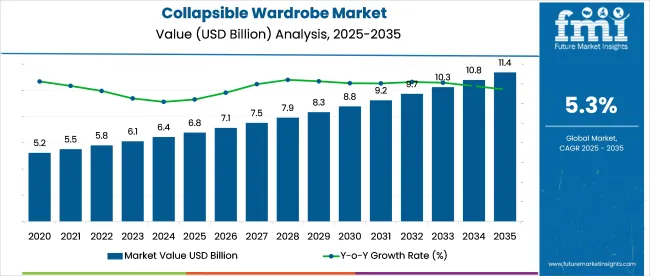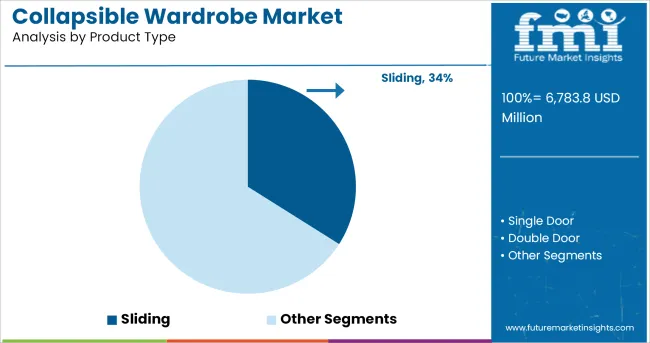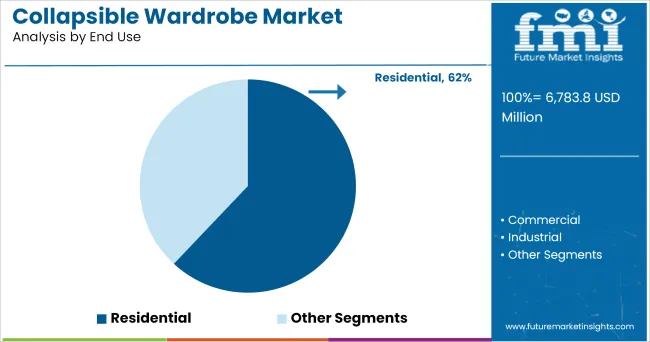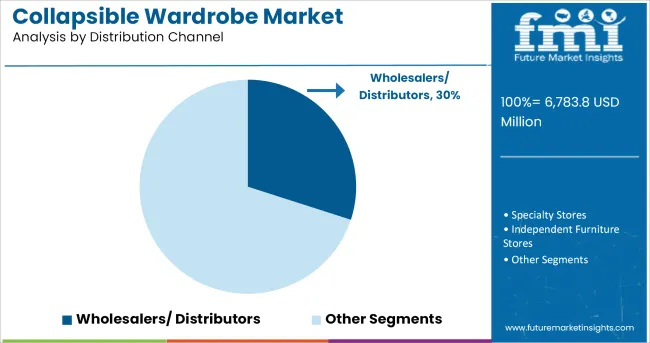The Collapsible Wardrobe Market is estimated to be valued at USD 6.8 Billion in 2025 and is projected to reach USD 11.4 Billion by 2035, registering a compound annual growth rate (CAGR) of 5.3% over the forecast period.

The collapsible wardrobe market is witnessing strong growth momentum, driven by evolving urban lifestyles, shrinking living spaces, and consumer preference for modular, easy toassemble storage solutions. Rising urbanization and the growing population of renters and shared housing occupants have heightened demand for portable and compact furniture
Manufacturers are focusing on lightweight yet durable materials, incorporating features such as foldability, dust-proofing, and quick installation to cater to the needs of highly mobile consumers. Additionally, collapsible wardrobes are gaining traction as a sustainable alternative to traditional wooden wardrobes, owing to their lower environmental footprint in production and transportation.
The market is further supported by the rise in direct to consumer brands and online platforms offering a wide variety of customizable options. In the coming years, innovation in materials, hybrid designs with multifunctional usage, and alignment with global minimalist trends are expected to unlock new market opportunities across both developed and emerging regions.
The market is segmented by Product Type, End Use, and Distribution Channel and region. By Product Type, the market is divided into Sliding, Single Door, Double Door, and Others. In terms of End Use, the market is classified into Residential, Commercial, and Industrial.
Based on Distribution Channel, the market is segmented into Wholesalers/ Distributors, Specialty Stores, Independent Furniture Stores, Online Retailers, and Others. Regionally, the market is classified into North America, Latin America, Western Europe, Eastern Europe, Balkan & Baltic Countries, Russia & Belarus, Central Asia, East Asia, South Asia & Pacific, and the Middle East & Africa.

Sliding collapsible wardrobes are projected to account for 34.0% of the total revenue share in 2025, making them the leading product type in the market. Their popularity is attributed to space-saving functionality and sleek design that suits compact living environments.
Sliding mechanisms eliminate the need for additional clearance space required by hinged doors, making them ideal for urban apartments and shared rooms. Enhanced aesthetics, ease of access, and minimalistic styling have made sliding wardrobes a preferred choice among young consumers and interior designers.
Manufacturers are offering modular sliding wardrobes with enhanced durability and storage versatility, often incorporating compartments, hanging rods, and customizable shelving. Additionally, improvements in panel materials and track systems have enhanced product lifespan and user convenience, reinforcing this segment’s position as a top-performing category in the collapsible wardrobe market.

The residential segment is anticipated to hold a commanding 62.0% share of the collapsible wardrobe market revenue in 2025, cementing its status as the dominant end-use category. This leadership is driven by the widespread use of collapsible wardrobes in urban homes rental accommodations, student housing, and temporary living setups. Their affordability portability, and assembly-friendly design make them an attractive solution for consumers seeking non-permanent, space-efficient furniture
The rise of minimalist interior trends and multifunctional living spaces has further accelerated residential adoption. Moreover increased consumer mobility and frequent relocation among urban professionals have reinforced demand for flexible, dismountable storage options
Manufacturers targeting the residential segment have responded with a variety of sizes, materials, and styles to address the diverse preferences of modern households. As residential housing trends continue to shift toward compact and modular solutions, the collapsible wardrobe is expected to remain a staple furnishing category.

Wholesalers and distributors are forecast to account for 30.0% of revenue in 2025 under the distribution channel category, making them a key driver of product availability and market penetration. This leadership is underpinned by their role in enabling bulk procurement and geographic reach across both urban and semi-urban retail markets.
By acting as intermediaries between manufacturers and small retailers or local furniture outlets, wholesalers ensure consistent stock availability and logistical support. Their cost-efficiency and ability to handle diverse product lines allow manufacturers to scale operations without extensive direct-to-consumer infrastructure.
Additionally, distributors often maintain long-standing relationships with furniture showrooms and regional retailers, facilitating market education and product display. As demand rises in tier 2 and tier 3 cities, wholesalers and distributors are expected to play a pivotal role in driving collapsible wardrobe adoption through wide distribution networks and localized inventory strategies.
The collapsible wardrobe market is set to witness steady growth during 2025 to 2035, with a CAGR of around 5.3%. Demand for collapsible wardrobes will witness steady growth owing to the evolving lifestyles of individuals.
Moreover, the logistics handling of collapsible wardrobes is much easier compared to the assembled ones. Such factors are likely to the projected high growth rate of collapsible wardrobe in terms of sales.
The collapsible wardrobe industry has a vast opportunity in the market due to some of its premium properties such as its ability to improve ergonomics, especially in the manufacturing areas as it has comparatively lower prices when it comes to material handling, packaging, and trading of such products.
Another factor driving the sales of collapsible wardrobe is its physical strength, durability, reliability, and longer usable duration which makes it more attractive to the customers thus, expands its market presence worldwide.
Further, its performance has led to growing demand in various sectors like automotive, pharmaceutical, automobile, and textile industries that are expected to boost the sales of collapsible wardrobes.
The enormously growing trading activities between countries is anticipated to fuel the demand for collapsible wardrobe.
The various abilities in the utilization of collapsible wardrobe like the provision of efficient space during transportation, easier handling of goods that are bulk when in assembled shape, further, the composite material used for the production of collapsible wardrobe allows the product to be recycled, therefore, which in turn is growing the sales of collapsible wardrobe in the market.
One of the major factors affecting the logistics industry is the non-availability of space that reduces the number of goods that can be carried and thus, increases the operational cost, as it requires multiple back and forth vehicles to shift the goods to the desired location.
Therefore, the collapsible wardrobes completely run over such factors and allow a comparatively larger amount of trading of goods.

The USA is one of the largest markets for collapsible wardrobes globally.
Demand for collapsible wardrobes in USA and Canada is anticipated to be driven due to the presence of various manufacturers and suppliers pharmaceutical industies, cosmetics, electronics goods, and residential areas which is likely to boost the demand for collapsible wardrobes industry during the forecast period.
The USA collapsible wardrobe sales were impacted by the construction sector in 2024. The USA construction sector faces a challenging year; however, there is a growing optimism that will allow low mortgage rates to drive the construction industry and will create new growth opportunities for collapsible wardrobes during the forecast period 2024 to 2035.

The rapid urbanization and growing strength of the middle-class population are likely to couple the growth in the residential sectors, followed by growing demand for technological advancements in the furniture industry.
Additionally, the reducing size of houses with the industrial developments and presence of collapsible furniture like chairs, tables, beds, and others are likely to create new opportunities for collapsible wardrobes in the countries of Europe.
The decline in the working of industries had hit the revenue hard as it was a necessary step observing the rising number of cases of Coronavirus. Further, the implementation of drastic regulations, ban on the trade of goods impacted the collapsible wardrobe industry.

Some of the leading manufacturers and suppliers of collapsible wardrobe include
The report is a compilation of first-hand information, qualitative and quantitative assessment by industry analysts, inputs from industry experts and industry participants across the value chain. The report provides in-depth analysis of parent market trends, macro-economic indicators and governing factors along with market attractiveness as per segments.
The report also maps the qualitative impact of various market factors on market segments and geographies.
The global collapsible wardrobe market is estimated to be valued at USD 6.8 Billion in 2025.
The market size for the collapsible wardrobe market is projected to reach USD 11.4 Billion by 2035.
The collapsible wardrobe market is expected to grow at a 5.3% CAGR between 2025 and 2035.
The key product types in collapsible wardrobe market are sliding, single door, double door and others.
In terms of end use, residential segment to command 62.0% share in the collapsible wardrobe market in 2025.






Full Research Suite comprises of:
Market outlook & trends analysis
Interviews & case studies
Strategic recommendations
Vendor profiles & capabilities analysis
5-year forecasts
8 regions and 60+ country-level data splits
Market segment data splits
12 months of continuous data updates
DELIVERED AS:
PDF EXCEL ONLINE
Collapsible Rigid Containers Market Size and Share Forecast Outlook 2025 to 2035
Collapsible Metal Tubes Market Size and Share Forecast Outlook 2025 to 2035
Collapsible Gates Market Size and Share Forecast Outlook 2025 to 2035
Collapsible Water Bottle Market Size and Share Forecast Outlook 2025 to 2035
Collapsible Fuel Tank Market Analysis - Size and Share Forecast Outlook 2025 to 2035
Collapsible Sleeve Containers Market Growth-Forecast 2025 to 2035
Industry Share Analysis for Collapsible Water Bottle Companies
Competitive Landscape of Collapsible Rigid Containers Providers
Collapsible Jerry Can Market Growth - Size & Forecast 2024 to 2034
Collapsible Food Packaging Containers Market
Collapsible Aluminium Tube Market
Foldable And Collapsible Pallets Market Size and Share Forecast Outlook 2025 to 2035
Wardrobe Boxes Market Size and Share Forecast Outlook 2025 to 2035

Thank you!
You will receive an email from our Business Development Manager. Please be sure to check your SPAM/JUNK folder too.
Chat With
MaRIA